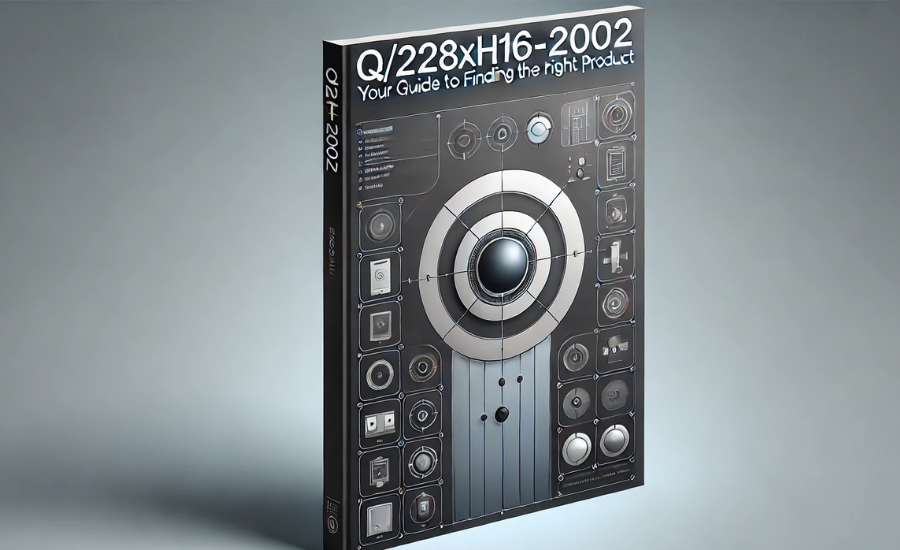Unlocking the Potential of Q/28xh16-2002: Transforming Industries with Cutting-Edge Innovation
The Q/28xh16-2002 is rapidly gaining recognition for its groundbreaking advancements, driving attention due to its impressive features and forward-thinking design. This emerging technology is creating significant shifts across multiple industries, offering fresh opportunities for innovation. Whether you’re deeply embedded in the tech landscape or exploring new technologies, understanding the Q/28xh16-2002 is crucial for recognizing its transformative influence on various sectors.
From its development to its current applications, the Q/28xh16-2002 continues to redefine possibilities, offering unique solutions that cater to modern business needs. Its adaptability and cutting-edge capabilities make it an invaluable asset for those seeking to stay ahead in an ever-evolving technological world. By delving into its key components and the ways it is being integrated across different fields, professionals can uncover new ways to leverage its potential and enhance operational efficiency.
Origins and Early Development of Q/28xh16-2002

The Q/28xh16-2002’s journey began in the early 2000s, fueled by the desire to solve some of the most challenging issues faced across multiple industries. Researchers and innovators aimed to create a highly efficient solution that could address complex problems while also offering significant improvements in performance and reliability. During its initial development, a key focus was on performance metrics, which led to the creation of early prototypes designed to withstand demanding environments. Engineers employed a methodical, iterative approach, which included rigorous testing and refinement, ensuring that each version was an improvement over the last.
Advancements and Materials Integration
As new breakthroughs in materials science emerged, the Q/28xh16-2002 saw significant improvements in its structure and functionality. Developers incorporated advanced compounds, allowing the technology to function more effectively and extend its range of applications. The inclusion of these novel materials enhanced the durability and operational capacity of the technology, addressing the needs of a broader spectrum of industries. This innovative approach resulted in a product that exceeded initial expectations and opened the door to a wider array of use cases, making it adaptable to a variety of environments.
Widespread Adoption and Industry Impact
By collaborating with industry leaders across sectors like manufacturing and telecommunications, the Q/28xh16-2002 quickly gained recognition. User feedback from diverse fields played a pivotal role in shaping its design, ensuring that it met real-world requirements and continued to evolve. Today, the Q/28xh16-2002 stands as a prime example of technological advancement, demonstrating how continuous improvement, driven by both scientific research and industry demand, can create a lasting impact. Its successful integration into various industries highlights its transformative potential, positioning it as a crucial asset for businesses aiming to stay at the forefront of innovation.
Versatile Applications Across Industries

The Q/28xh16-2002 technology is quickly becoming an integral part of multiple sectors due to its versatility and innovative features. In manufacturing, this technology is helping optimise production lines by increasing precision and reducing material waste. This leads to smoother, more efficient operations, allowing manufacturers to meet high-demand standards while maintaining cost-effectiveness. Its ability to enhance processes and improve productivity is transforming the way businesses approach manufacturing challenges.
Advancements in Healthcare and Telecommunications
In healthcare, the Q/28xh16-2002 is revolutionising data management systems. It provides healthcare professionals with accurate and easily accessible patient records, enabling faster decision-making and more efficient workflows. The enhanced precision of this technology ensures that critical medical data is reliably stored and retrieved, significantly improving the quality of care. In telecommunications, the Q/28xh16-2002 optimises signal processing and boosts network performance. This ensures that communication systems are more reliable, offering smoother and more consistent connections for users.
Impact on Automotive Safety and Broader Technological Integration
The automotive industry is another area benefiting from the capabilities of the Q/28xh16-2002. This technology plays a vital role in the development of advanced driver-assistance systems (ADAS), improving vehicle safety and contributing to the prevention of accidents. Its integration into vehicles helps provide features such as lane-keeping assistance, collision avoidance, and adaptive cruise control. As industries across healthcare, telecommunications, and automotive continue to embrace the Q/28xh16-2002, its wide range of applications demonstrates its powerful impact on modern technology and its capacity to drive progress in diverse fields.
Essential Attributes of the Q/28xh16-2002

Innovative Design and Efficient Integration
The Q/28xh16-2002 is recognized for its forward-thinking design, which allows for effortless integration into various systems without sacrificing performance. Its compact form factor ensures that it can fit seamlessly into different setups, offering enhanced flexibility without compromising its functional capabilities. This design philosophy is key to ensuring that the technology can be used in a wide range of applications, making it a versatile solution for various industries looking to optimise their systems and processes.
Energy Efficiency and Durability
A standout feature of the Q/28xh16-2002 is its exceptional energy efficiency. By significantly reducing energy consumption while maximising output, it provides an environmentally friendly solution for organisations looking to improve sustainability. In addition to its efficiency, the model is built to be incredibly durable. The use of high-quality, robust materials ensures that it can endure even the most demanding environments, standing up to industrial wear and tear with ease. This durability makes it a reliable choice for long-term use in challenging conditions, ensuring longevity and minimal maintenance.
Versatility and Connectivity
Another defining characteristic of the Q/28xh16-2002 is its impressive versatility. It seamlessly adapts to a broad spectrum of applications across industries such as manufacturing and telecommunications, providing tailored solutions that meet specific needs. Additionally, its user-friendly interface allows operators to easily monitor performance metrics in real-time, ensuring optimal functionality. The technology also supports advanced connectivity features, enabling smooth data transfer between devices. This capability significantly enhances workflow efficiency, making it an invaluable asset for any organisation aiming to streamline operations and maintain continuous, efficient processes.
Key Benefits of the Q/28xh16-2002

The Q/28xh16-2002 is recognized for its numerous advantages that make it a valuable tool across various sectors. One of the most notable features is its impressive efficiency, enabling rapid processing without sacrificing quality. This high-speed capability is particularly beneficial in manufacturing and production settings, where it can significantly boost productivity and streamline operations. By offering both speed and precision, it supports businesses in meeting their performance targets more effectively.
Flexibility and Seamless Integration
One of the standout benefits of the Q/28xh16-2002 is its exceptional flexibility. This technology is designed to integrate effortlessly with existing systems, allowing organisations to upgrade their infrastructure without the need for costly and time-consuming overhauls. This smooth integration is highly valued by users, as it helps ensure continuity in day-to-day operations and minimises disruptions during the transition. The flexibility of the Q/28xh16-2002 enhances its appeal, enabling businesses to enhance their technology stack without overhauling entire systems.
Considerations and Potential Challenges
While the Q/28xh16-2002 offers many benefits, it’s important to consider potential drawbacks. The initial investment required to adopt this technology may be substantial, which could pose a barrier for some organisations, especially smaller businesses. Additionally, while the Q/28xh16-2002 excels in certain applications, it may not provide the same level of performance in all scenarios, which could limit its versatility in specific use cases. Moreover, training staff to fully leverage its features may take time and resources, presenting an additional challenge for businesses seeking a quick return on investment. Organisations must carefully evaluate these factors to determine whether the potential benefits outweigh the costs.
Unique Design and Functionality of the Q/28xh16-2002
When assessing the Q/28xh16-2002, it’s important to understand how it stands out in a crowded marketplace. Its innovative design and cutting-edge functionality place it ahead of many competing technologies. Unlike many alternatives, the Q/28xh16-2002 combines performance and efficiency in a way that ensures it delivers superior results. This approach not only enhances productivity but also ensures the technology remains relevant across a range of applications, positioning it as a strong contender in its field.
Efficiency and Versatility Across Industries
One of the key advantages of the Q/28xh16-2002 is its exceptional resource management. While many competing technologies tend to prioritise power consumption, the Q/28xh16-2002 focuses on optimising its performance without increasing energy use. This efficient approach makes it a sustainable option for companies looking to balance operational output with environmental responsibility. In addition to its efficiency, the technology’s adaptability is another crucial point of distinction. Unlike systems designed for specific niches, the Q/28xh16-2002 can be effectively utilised across a variety of industries, from manufacturing to healthcare, making it a versatile choice for organisations looking to integrate new technologies into diverse applications.
User Accessibility and Competitive Advantage
Another significant aspect that sets the Q/28xh16-2002 apart from other systems is its user-friendly interface. Unlike many technologies that can be complex or difficult for operators to master, the Q/28xh16-2002 offers an intuitive design that streamlines operations for users of all experience levels. This ease of use helps increase overall operational efficiency, as it allows staff to quickly adapt and engage with the system. When compared to other technologies on the market today, the Q/28xh16-2002 maintains a competitive edge, not only due to its innovative design but also because of its broad applicability With its user-friendly design and intuitive interface, the Q/28xh16-2002 stands out as an ideal option for businesses looking for a streamlined and versatile solution.
Future Prospects of the Q/28xh16-2002

The future of the Q/28xh16-2002 technology is full of promising possibilities as it continues to evolve and adapt to new technological advancements. With each passing year, its potential to impact various industries grows exponentially. As artificial intelligence (AI) continues to improve, the integration of the Q/28xh16-2002 into AI systems could lead to advancements in data processing capabilities, facilitating the development of smarter algorithms and more streamlined operations across multiple fields. This would allow businesses and organisations to leverage its advanced features for enhanced decision-making and operational efficiency.
Expanding Applications in IoT and Healthcare
The Q/28xh16-2002 also holds significant potential in the Internet of Things (IoT) sector, where its capabilities could transform smart cities and homes. By incorporating this technology into IoT networks, real-time data analysis could drastically improve how resources are managed, optimising everything from energy consumption to waste management. This innovation could usher in a new era of sustainability by helping cities and individuals reduce their environmental footprint. In healthcare, the Q/28xh16-2002’s precision could lead to groundbreaking advancements in diagnostics and personalised medicine, enhancing the ability to tailor treatments to individual patients based on data-driven insights.
Supporting Sustainability and Innovation
Beyond its immediate applications in AI and IoT, the Q/28xh16-2002 could play a crucial role in helping industries meet sustainability goals. By minimising waste and optimising processes, it can help businesses align with global environmental objectives while improving their bottom line. As research and development continue to drive its evolution, the Q/28xh16-2002 has the potential to lead to breakthroughs that could revolutionise entire industries. The path ahead is filled with exciting possibilities, as this technology promises to be a cornerstone of future innovation across multiple sectors, ensuring its relevance for years to come.
Conclusion
The Q/28xh16-2002 technology represents a significant leap forward in multiple industries, offering enhanced efficiency, adaptability, and versatility. Its innovative design and performance capabilities make it a valuable asset in fields like manufacturing, healthcare, telecommunications, and automotive safety. As it continues to evolve, the Q/28xh16-2002 promises even greater potential, driving innovation and sustainability while shaping the future of various sectors. Its ability to seamlessly integrate with existing systems, improve operational efficiency, and support sustainability makes it a key player in modern technological advancements.
FAQs
Q1. What is the Q/28xh16-2002 technology?
A. The Q/28xh16-2002 is an advanced technology designed to improve efficiency, precision, and functionality across various industries. It has applications in sectors like manufacturing, healthcare, telecommunications, and automotive, offering innovative solutions for modern business challenges.
Q2. How does the Q/28xh16-2002 impact industries?
A. This technology is driving change by optimising processes in manufacturing, enhancing healthcare data management, and improving network performance in telecommunications. It also plays a key role in automotive safety with advanced driver-assistance systems (ADAS).
Q3. What are the main benefits of using Q/28xh16-2002?
A. The Q/28xh16-2002 offers several advantages, including exceptional energy efficiency, durability, and versatility. It integrates seamlessly into existing systems, allowing businesses to optimise operations without major overhauls. Additionally, it enhances productivity while minimising energy consumption.
Q4. What industries benefit the most from the Q/28xh16-2002?
A. Industries such as manufacturing, healthcare, telecommunications, and automotive have all benefited significantly from the Q/28xh16-2002’s integration. Its versatility allows it to be adapted to a wide range of applications across these sectors.
Q5. What challenges might businesses face when adopting the Q/28xh16-2002?
A. While the Q/28xh16-2002 offers many benefits, businesses may face challenges such as the high initial investment required for adoption and the time needed for staff training. Additionally, its performance may vary depending on the specific application.
Q6. What is the future potential of Q/28xh16-2002?
A. The future of the Q/28xh16-2002 is promising, especially with its potential integration into artificial intelligence systems and the Internet of Things (IoT). This could lead to smarter, more efficient operations and innovations in sectors such as healthcare and sustainability.
Q7. How does the Q/28xh16-2002 contribute to sustainability?
A. By optimising processes and reducing waste, the Q/28xh16-2002 technology helps businesses achieve sustainability goals. It plays a key role in making industries more energy-efficient, contributing to both environmental and operational improvements.
Stay engaged to receive the most recent updates and important alerts: Arfraierq Faz Det Do





Post Comment